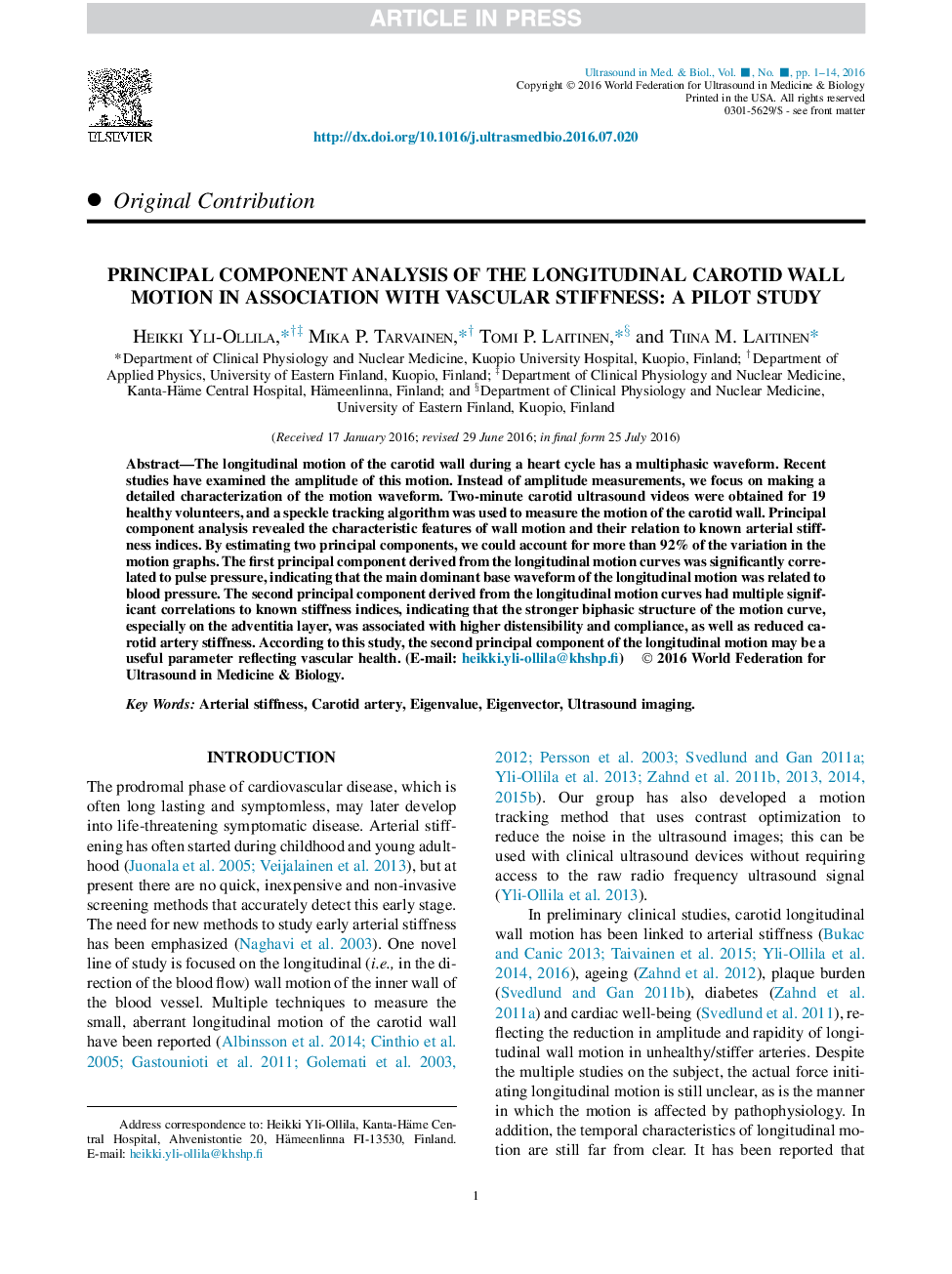| کد مقاله | کد نشریه | سال انتشار | مقاله انگلیسی | نسخه تمام متن |
|---|---|---|---|---|
| 5485782 | 1399440 | 2016 | 14 صفحه PDF | دانلود رایگان |
عنوان انگلیسی مقاله ISI
Principal Component Analysis of the Longitudinal Carotid Wall Motion in Association with Vascular Stiffness: A Pilot Study
ترجمه فارسی عنوان
تجزیه و تحلیل مولفه اصلی حرکت دیوار طولی کاروتید در ارتباط با سختی عروقی: یک مطالعه خلبان
دانلود مقاله + سفارش ترجمه
دانلود مقاله ISI انگلیسی
رایگان برای ایرانیان
کلمات کلیدی
ترجمه چکیده
حرکت طولی دیواره کاروتید در طی یک چرخه قلب یک شکل موج چند فاز دارد. مطالعات اخیر دامنه این حرکت را بررسی کرده اند. به جای اندازه گیری دامنه، ما بر روی ساختن مشخصات دقیق شکل موج حرکت تمرکز می کنیم. ویدیوهای اولتراسوند کاروتید دو دقیقه ای برای 19 داوطلب سالم به دست آمد و برای اندازه گیری حرکت دیواره کاروتید از الگوریتم ردیابی دقیق استفاده شد. تجزیه و تحلیل اجزای اصلی نشان داد ویژگی های مشخصی از حرکت دیوار و ارتباط آن با شاخص های سختی شریانی شناخته شده است. با برآورد دو مولفه اصلی، ما می توانیم بیش از 92٪ از تغییرات در نمودار حرکت را حساب کنیم. اولین مولفه اصلی مشتق شده از منحنی حرکت طولی به طور قابل توجهی با فشار پالس ارتباط داشت، که نشان می داد که شکل اصلی فرمان پایه حرکت طولی با فشار خون مرتبط بود. مولفه دوم دوم که منجر به حرکت منحنی طولی شد، همبستگی چندانی با شاخص های سختی شناخته شده داشت که نشان می داد ساختار دوهسته ای قوی تر از منحنی حرکت، به خصوص در لایه آلودگی، با تسلسل و انطباق بالاتر و همچنین کاهش کاردیومی عروق سفتی، سختی. با توجه به این مطالعه، مولفه دوم حرکت طولی می تواند یک پارامتر مفید باشد که نشان دهنده سلامت عروقی است.
موضوعات مرتبط
مهندسی و علوم پایه
فیزیک و نجوم
آکوستیک و فرا صوت
چکیده انگلیسی
The longitudinal motion of the carotid wall during a heart cycle has a multiphasic waveform. Recent studies have examined the amplitude of this motion. Instead of amplitude measurements, we focus on making a detailed characterization of the motion waveform. Two-minute carotid ultrasound videos were obtained for 19 healthy volunteers, and a speckle tracking algorithm was used to measure the motion of the carotid wall. Principal component analysis revealed the characteristic features of wall motion and their relation to known arterial stiffness indices. By estimating two principal components, we could account for more than 92% of the variation in the motion graphs. The first principal component derived from the longitudinal motion curves was significantly correlated to pulse pressure, indicating that the main dominant base waveform of the longitudinal motion was related to blood pressure. The second principal component derived from the longitudinal motion curves had multiple significant correlations to known stiffness indices, indicating that the stronger biphasic structure of the motion curve, especially on the adventitia layer, was associated with higher distensibility and compliance, as well as reduced carotid artery stiffness. According to this study, the second principal component of the longitudinal motion may be a useful parameter reflecting vascular health.
ناشر
Database: Elsevier - ScienceDirect (ساینس دایرکت)
Journal: Ultrasound in Medicine & Biology - Volume 42, Issue 12, December 2016, Pages 2873-2886
Journal: Ultrasound in Medicine & Biology - Volume 42, Issue 12, December 2016, Pages 2873-2886
نویسندگان
Heikki Yli-Ollila, Mika P. Tarvainen, Tomi P. Laitinen, Tiina M. Laitinen,
